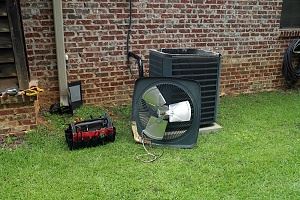HVAC systems have become a regular part of the average American household. It is estimated 90% of households in the U.S. have some sort of air conditioning system. The sheer number of HVAC units within the US means millions of Americans every year need to consider replacing their existing HVAC units. Energy Star states the average HVAC system should be replaced after ten years. Upgrading an existing HVAC system guarantees access to more energy-efficient features and the chance to make greater savings on those monthly energy bills. There are a few things that you need to know before an HVAC replacement.

![]()
Know your HVAC replacement costs before an HVAC replacement
The replacement costs of an HVAC unit depend on a wide variety of factors. Estimates are done by a professional who will be required to enter your home to measure the square footage of the room where your HVAC system is and calculate the load based on factors like the area’s local climate and the property’s ability to contain conditioned air. Homeowners should know what to expect regarding the size of the model. A professional contractor will be able to determine the right size more accurately.
This process is necessary for households to make an informed decision on the best type of HVAC system and any additional ductwork or insulation that may need to be included. A professional will list various models and the ones they recommend based on their calculations.
Two important terms you need to know before an HVAC replacement
The final decision regarding the best replacement HVAC unit rests with the owner of the property. Rather than relying exclusively on the recommendations of a professional, householders should seek to educate themselves on two important terms–HSPF and SEER. Higher HSPF and SEER rated units will always cost more, but these units also come with a higher return on investment in the long term.
Heating Season Performance Factor (HSPF)
The HSPF factor refers to the operational efficiency of the heating pump. As a condition to enter the market, all new units must have a HSPF of at least 7.7. This requirement only applies to new heat pumps. Existing units may have lower HSPF ratings.
Seasonal Energy Efficient Ratio (SEER)
The SEER rating is used to determine the efficiency of an HVAC unit’s cooling system. , A minimum rating of 13 is the standard all new units must meet to enter the market. This requirement does not apply to older models.
Duration of a HVAC replacement job
Once a new HVAC unit has been selected and a contractor has scheduled a day for the work to begin, it is imperative householders adequately prepare their homes to prevent any delays.
The majority of HVAC replacements can be completed in a single day. Only more advanced units may require an additional day to complete the installation. Once the HVAC contractor will arrive at your home they will then begin setting up their work areas. Take note, as this may require them to gain access to less used areas of the property, such as attics and crawl spaces.
The steps an HVAC crew are to follow may vary depending on your individual application. Once the workspace has been prepped, the crew will begin the work of installing the new unit.
Possible unforeseen repairs
Home improvement projects often yield unforeseen obstacles. Reputable HVAC contractors will always try to cover every possible scenario in their written estimate.
Sometimes additional repair work may need to be carried out. For example, rotten wall studs, repairs to the drywall and any damaged ductwork may need to be repaired during the project. Unforeseen repairs will not be included within the written estimate as they may only be discovered in the middle of the project. Homeowners should have space in their budgets to cover any unforeseen repairs.
Testing the new HVAC system
Once a new HVAC system has been installed, the contractor will perform tests and checks. Assuming nothing has gone wrong, the contractors will inspect the system before adding the refrigerant.
The system will then be activated with the refrigerant inside and all components will be retested to ensure everything is working as it should. The contractor will provide a full brief on how to operate the system, as well as full warranty information. Homeowners will also have the opportunity to ask any questions regarding the operation of their new HVAC system.
Consider professional HVAC replacement services with Presidential Heating & Air Conditioning
Fixing an HVAC unit can be a big job. As well as selecting the right HVAC replacement service and the best model for your budget. Before determining whether an HVAC unit should be replaced, consult with a professional first. They will be able to offer an informed opinion on whether it is worth repairing an existing unit or opting for the full replacement. If you need a reputable HVAC provider, call or reach out online to the professional HVAC contractors at Presidential Heating & Air Conditioning.

